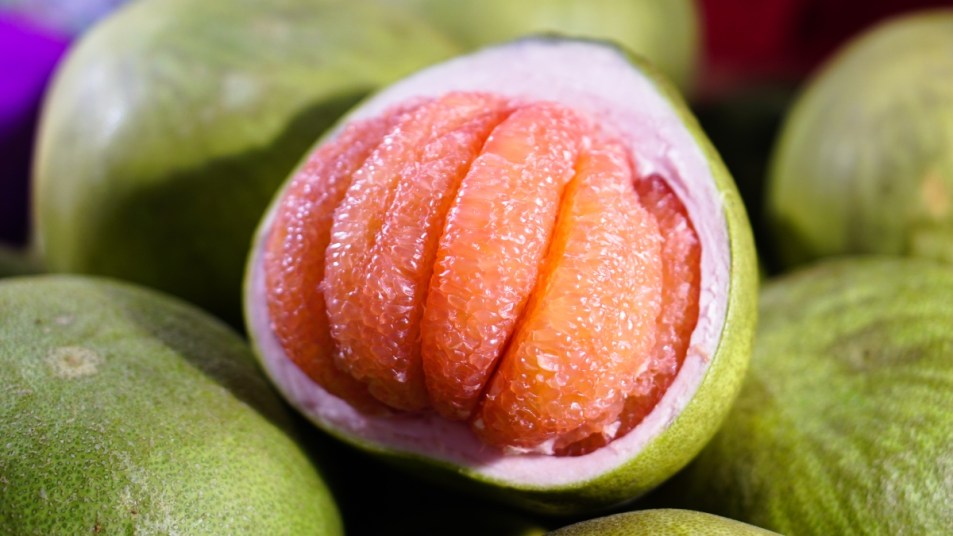Everything You Should Know About Grapefruit’s Cousin — the Pomelo
They're big, green, flavor and nutrient machines.

Have you ever walked into the grocery store in the fall or winter and been intrigued by the huge green fruit nestled among its much smaller citrus cousins? That jolly green giant is the humble pomelo, a citrus fruit that’s botanically related to the grapefruit. If you’ve tasted it, you know it’s worth taking home. But if you’re unfamiliar with pomelos, here are some basic things you should know about them.
What is a pomelo?
Pomelos (also called pummelos) are large, round, green citrus fruits with bright pink flesh inside. They are often compared to grapefruits due to their size and flavor, but grapefruits are actually a hybrid of crossbreeding pomelos and oranges. Specialty Produce explains that pomelos are the largest of all citrus fruits, ranging in size from that of a “baby cantaloupe to almost basketball size.” They originated in southeastern Asia and Malaysia, but are also grown in warm regions of the western United States from the fall to the spring. They grow on tall trees that also produce large, white flowers valued for their sweet fragrance and used to make perfume. Though they’re relatively common and accessible today, historians note that pomelos were highly prized status symbols in Ancient Rome. Fruit fit for royalty!
What do pomelos taste like?
Upon slicing open a pomelo for the first time, you might be stricken by how similar it looks to a grapefruit. It is rosy pink and membranous inside. Its pith, however, is much thicker and spongier than that of a grapefruit. Its taste is similar as well, but sweeter and less tangy. Specialty Produce notes that it may be acidic or sweet, but pomelos never taste bitter. It smells fresh, clean, and heavily floral, which contributes some floral notes to its flavor as well (a taste of springtime in the middle of winter!). Texturally, it’s like most other citrus fruits — pulpy, juicy, and soft. Eating a pomelo is a familiar enough experience to not be strange, but different enough to be exciting.
How To Eat a Pomelo
Because of its similarity to grapefruit, you can eat it in the same traditional way: by slicing it in half and scooping the segments out with a spoon. This might be the easiest way to tackle a pomelo due to its size, but you can also cut it into slices like you would an orange. Whatever you do, don’t throw away the peel — because it’s so thick and fragrant, it is often candied. Pomelo fruit is delicious on its own, but pairs well with Thai and Asian flavors, according to Specialty Produce, as well as seafood, garlic, chiles, peanuts, and coconut.
Check out this simple and delicious recipe from Rasa Malaysia for Yam Som-O, a popular pomelo salad that incorporates a lot of the above flavors.
Yam Som-O (Pomelo Salad)
Ingredients:
- 1 large pomelo, peeled and segmented
- 1 pound peeled and deveined shrimp
- ¾ cup unsweetened desiccated coconut flakes
- ½ cup coconut milk
- Dried red chile flakes to taste
- 4 tablespoons minced onion or shallots
- 2 tablespoons garlic
- 2 tablespoons vegetable oil
- ½ cup plain roasted peanuts, roughly chopped
- Fresh lime juice to tastes
- Fish sauce to taste
- A handful fresh cilantro leaves
Directions:
- Sauté garlic, onion, pepper flakes in vegetable oil over medium heat until fragrant, add coconut milk and heat thoroughly, then set aside to cool.
- Dry-toast coconut flakes in another skillet over medium-low until they turn medium brown. Be careful — coconut burns easily.
- Poach and drain shrimp, set aside to cool.
- Combine shrimp, coconut milk mixture, toasted coconut, peanuts, cilantro, and pomelo in large bowl.
- Add lime juice and fish sauce, toss gently by hand, and serve immediately.
What are the health benefits of pomelos?
Like other citrus fruits, pomelos boast a wealth of health benefits. According to Medical News Today, 100 grams of peeled pomelo contains:
- 38 calories
- 0.75 grams protein
- 0.04 grams fat
- 9.62 grams carbohydrates
- 1 gram fiber
- 4 milligrams calcium
- 0.11 milligrams iron
- 8 IU vitamin A
- 0.03 milligrams thiamine
- 0.03 milligrams riboflavin
- 0.2 grams niacin
- 61 milligrams vitamin C
Considering a standard, whole, peeled pomelo is about 609 grams, this fruit is truly jam-packed with nutrients. Medical News Today notes that some of pomelo’s health benefits include high amounts of fiber — which reduces risk of diabetes, some cancers, obesity, and heart disease; anti-inflammatory and antioxidant properties — which help fight sickness and contribute to overall wellness; high amounts of vitamin C — which maintains bone, blood vessel, cellular, and skin health; and high amounts of vitamin A — which aids in bone and eye health and may reduce cancer risk.
VeryWellFit adds that pomelos are high in potassium, which helps regulate blood pressure, and contribute to digestive health. One study found that citrus fruits like pomelos can reduce stroke risk in women due to their high amounts of flavonoids. Besides its pleasant taste and aroma, it seems like there are endless health-related reasons you may want to start snacking on pomelos!
What to Know Before You Eat Pomelos
Before you throw a few pomelos in your shopping cart, there are some health concerns to be aware of. Yes, they have a lot of health benefits — but, like grapefruits, some components of pomelos may interact with prescription drugs. These components may increase the amounts of medication in your bloodstream to potentially toxic levels or make the medication less effective. The Food and Drug Administration recommends avoiding grapefruit and pomelo if you take medications including, but not limited to:
- Some orticosteroids (to treat ulcerative colitis or Crohn’s Disease)
- Some statins (to lower cholesterol)
- Some anti-anxiety drugs
- Some antihistamines (to treat allergies)
- Some drugs that treat high blood pressure
- Some drugs that treat heart arrhythmia
- Some organ-transplant rejection drugs
Whether or not you’re certain your medications interact with grapefruits or pomelos, it’s a good idea to check with your healthcare provider before adding it to your diet. Pomelos are delicious, but they certainly aren’t worth risking your health and safety.
Can you find pomelos in your grocery store this season? If you’re able, test one out and see if you like it. It might just become your new favorite fruit.
This content is not a substitute for professional medical advice or diagnosis. Always consult your physician before pursuing any treatment plan.













